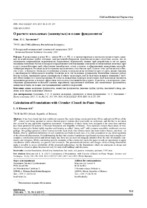О расчете кольцевых (замкнутых) в плане фундаментов
Another Title
Calculation of Foundations with Circular (Closed) in-Plane Shapes
Bibliographic entry
Хасеневич, Л. С. О расчете кольцевых (замкнутых) в плане фундаментов = Calculation of Foundations with Circular (Closed) in-Plane Shapes / Л. С. Хасеневич // Наука и техника. – 2017. – № 2. - С. 153–159.
Abstract
В возведенных в конце 80-х – начале 90-х гг. ΧΧ ст. и эксплуатируемых в настоящее время четырех дымовых железобетонных трубах тепловых электростанций обнаружено практически полное отсутствие осадок, что не учитывается современными нормативными документами. Фундаменты данных труб разработаны в это же время, защищены патентами России и Беларуси и представляют собой кольцевые основания из погруженных вплотную друг к другу железобетонных свай, образующих своеобразную «стену в грунте» и объединенных монолитным железобетонным ростверком. Ростверк является прямым продолжением стен стволов труб. Одна из этих труб возведена в России, а три – в Беларуси. Поскольку и грунтовые условия, и нагрузки резко отличаются друг от друга, можно говорить о закономерности наблюдаемого явления. Несмотря на то что кольцевые фундаменты значительно снижают расход бетона и стали, уменьшают время строительства и объем трудозатрат, они не получили должного внимания у научной общественности и проектировщиков. В статье на конкретных примерах возведенных труб показана возможность применения расчетов, в которых эффективно используется пассивный отпор грунта. И расчеты, и конструкции существующих фундаментов позволяют оценить вероятность предлагаемой методики для аналогичных фундаментов,
замкнутых в плане, не только для промышленных зданий и сооружений.
Abstract in another language
It has been found that four reinforced concrete flue stacks being constructed in late 80-ies and early in 90-ies of the 20th century and being operated at various thermal power stations show practically no settlement, and this fact is not taken into account by any applicable regulatory documents. Foundations of these stacks were designed at the same time and they have been protected by patents of Russian Federation and Republic of Belarus. They represent circular bases made of reinforced concrete piles buried tightly together and forming so-called “slurry wall” with common monolithic reinforced concrete grillage. The grillage presents a direct extension of the stack shaft. One of these stacks has been built in Russia, and three – in Belarus. Due to significant differences in soil conditions and loads in each case, it is a fair assumption to say about regularity
of the observed phenomenon. Notwithstanding the fact that circular foundations significantly decrease steel and concrete consumption,
construction period and labour input, they have not yet received adequate attention from the side of scientific community and designers. While considering specific examples of the constructed stacks the paper reveals an opportunity to apply calculations which efficiently use passive soil resistance. The presented calculations and designs of the existing foundations make it possible to assess probability of the proposed methodology for the foundations which are analogous in design and which have closed in-plane structure not only for industrial buildings and structures.
View/
Collections
- №2[11]

